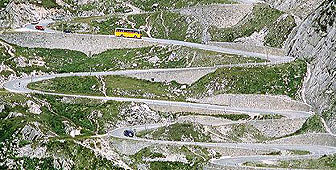Gateway to Ticino is cradle of Switzerland

The St Gotthard pass, which links the Italian-speaking canton of Ticino with German-speaking northern Switzerland, is not only one of Europe's most important North-South links. It also has great importance as a cultural link within Switzerland itself.
In fact the opening of the Alpine pass in the Middle Ages is one of the key events leading to the creation of the Swiss state, and subsequent efforts to secure control over the trade route explain why Ticino is part of Switzerland.
“The foundation of Switzerland is related to the Gotthard road,” says Carlo Peterposten, director of the National Museum of the St Gotthard, “because the road gained a very great importance, not only from the earnings made from transport but from the customs on the goods.”
The Gotthard was the last of the major alpine passes to be opened, mainly because of the difficulty of building a path through the narrow Schöllenen Gorge.
Although other Alpine passes, such as the Brenner, the Great St Bernard or the Simplon, were all well travelled by the time medieval engineers solved the problem at the end of the 12th century, the Gotthard quickly established itself as the most popular route.
At the time, the pass was the most direct trading route between Europe’s most dynamic regions: Lombardy in the south, and the German states, Champagne and Flanders in the north.
Mule pack drivers carried cheese, cloth, leather and metal goods from north to south, and returned with cereals, wine, oil, raw silk and cotton.
“The economic value of the trade was very big, and the people who controlled the traffic intended to keep it in their own hands and not have any foreign interference,” explained Peterposten.
To protect their trading route, the people of Uri, Schwyz and Unterwalden, on the northern access to the pass, joined forces to resist attempts by the Habsburgs of Austria to take control.
Their legendary mutual defence pact of 1291 is still widely considered as the founding act of a future Swiss state.
It was progressively extended to other cantons around Lake Lucerne, allowing the fledgling Confederation to consolidate its territory. When the Habsburgs withdrew from the region altogether in 1350, the Swiss were free to turn their attention to the southern side of the pass, what is now Ticino.
With a victory at the battle of Giornico in 1478, the Confederates finally wrested control of the Leventine valley from the Milanese dukes.
The Italian-speaking region on the southern side of the Alps was ruled directly by the Swiss confederation until it became a canton in its own right in 1803. But it was the rulers north of the Alps that benefited from the traffic, Ticino itself remaining a backwater which depended on the Milan region to sustain its economy.
Two events a little more than 100 years ago changed all that and led Ticino to look north. The first was Italian unification in 1861. After the country was unified, Rome threw up customs barriers at its borders, and Ticino was excluded from its traditional markets.
The second event was the construction of the Gotthard rail tunnel, which opened in 1882. Tazio Bottinelli, a Ticinese geographer, says the railway not only made exchanges with the rest of Switzerland easier, but also had a crucial and lasting impact on the canton’s development.
He said it helped make Ticino a more coherent and viable region.
“The railway unified Ticino along a north-south axis. It enabled Ticino, which was a largely artificial construction without an urban network of any cantonal significance, to develop in the years up to the First World War the urban network which is still in place today.”
Bottinelli goes even further, and claims that the region’s identity itself is a by-product of the tunnel’s construction.
“It created Ticino’s identity. Before that, there were various bits of Lombard territory that lost their points of reference after Italian unification, which were Como and Milan. They discovered a new identity through Ticino’s internal construction thanks to the railway,” he said.
“In fact, around the First World War, the new dialect that came to be spoken was know as the ‘railway’ dialect,” Bottinelli added.
The railway tunnel, and much later in 1980, the road tunnel, also helped the development of one of Ticino’s main industries – tourism.
However, the tunnel no longer lives up to expectations of high-speed rail travel, and can no longer take the growing amount of freight that travels between northern and southern Europe.
A new tunnel is already under construction, and politicians in Ticino see it as a key to helping this small region of 300,000 inhabitants carve out a role for itself at a time when Europe’s borders are becoming increasingly flexible.
“The new tunnel will create stronger relations with the rest of Switzerland as well as with Italy, and Lombardy in particular,” says Remigio Ratti, director of Italian-language radio and television and professor of economics at Ticino’s university.
“The scenario for Ticino’s future is as an intermediate region between Switzerland and Italy, and between two metropolitan areas, Zurich and Milan, and for this we need good transport and good communications.”
Eight hundred years after the pass was opened, the Gotthard is still the key axis in Switzerland’s transport network, and could hold the key to Ticino’s future development.
by Malcolm Shearmur

In compliance with the JTI standards
More: SWI swissinfo.ch certified by the Journalism Trust Initiative
You can find an overview of ongoing debates with our journalists here. Please join us!
If you want to start a conversation about a topic raised in this article or want to report factual errors, email us at english@swissinfo.ch.